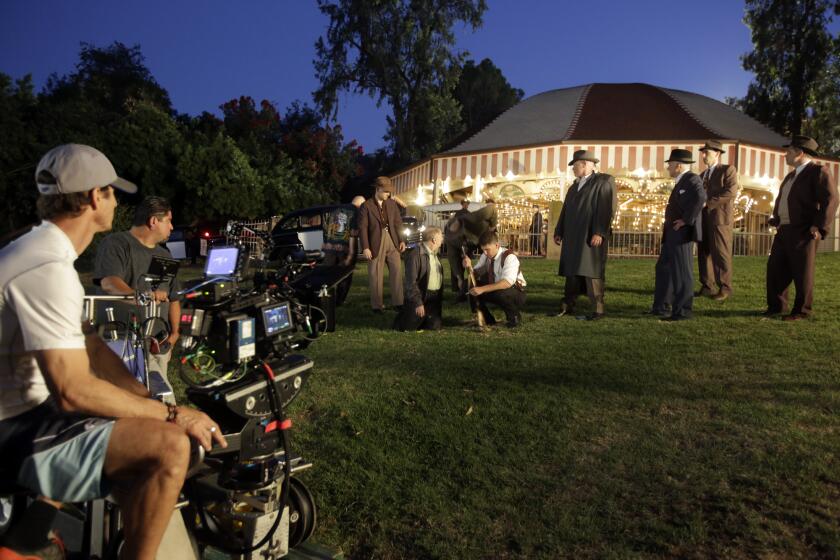Ahmanson Foes Talking Cash and PR With Owner
- Share via
As a publicity war continues over the Ahmanson Ranch project, opponents of the 3,050-home Ventura County development are quietly maneuvering to buy the ranch by delivering a package of cash and tax breaks that owner Washington Mutual Bank could find hard to resist.
“We’re helping Washington Mutual realize what the out is for them, that there are good financial options,” said Chad Griffin, director of a high-profile campaign to block construction of the controversial $2-billion golf course community overlooking the west San Fernando Valley.
“We’re talking to some of the nation’s top experts in structuring these types of deals,” he said.
The newly formed Rally to Save Ahmanson Ranch coalition, co-chaired by actor-director Rob Reiner, has asked top executives at Washington Mutual to discuss the financial and public relations benefit of selling the 2,800-acre property to the public, or turning it over to a land conservation agency.
Washington Mutual, which inherited the project after buying H. F. Ahmanson Co. in 1998, has insisted that the old cattle and sheep ranch near Calabasas is not for sale, and that construction will begin next year.
In a recent statement, the Seattle-based savings and loan suggested it had considered, and rejected, federal tax breaks through so-called conservation easements as an alternative to development.
“Our investors put greater weight on cash earnings than on tax benefits,” bank spokesman Tim McGarry said. “That and our belief that this project meets a need for new housing makes building it preferable to opting for conservation easements.”
However, Washington Mutual offered last month to have a consultant, former Interior Secretary Bruce Babbitt, meet with the coalition “as a first step toward meaningful discussions.”
“Following that meeting,” bank Chief Executive Kerry Killinger wrote in a letter to Reiner, “I would be happy to meet with you personally provided that Secretary Babbitt concludes that it would be constructive.”
Opponents consider a Babbitt meeting window dressing. But in a letter Thursday, they agreed to meet with him if that will lead to discussions with Killinger.
“We’re not going to meet with lobbyists hired by the developer,” Griffin said.
Approved by Ventura County in 1992, the Ahmanson Ranch project was stalled first by a series of lawsuits and is now being held up by studies of whether a rare frog and plant discovered on the ranch can survive if it is built.
Delays have even prompted some who support the project to question its future.
Architect Donald Brackenbush, designer of the Ahmanson Ranch development and president of Ahmanson Land Co. until 1997, said he thinks Washington Mutual might consider a sale because of the potential for even more delays and the beating the bank’s image is taking from project opponents.
“If the opposition wrote a check and went up to Seattle and explained to the [bank] administration what the risks are down here, I think they would probably have an interesting conversation,” Brackenbush said. “It’s a different program now. It’s Hollywood and money, and I don’t know how you deal with that.”
Developer Fred Maas, who helped cut the deal that led to the county’s approval of the project a decade ago, said he thinks it is virtually dead in its present form.
“Given current thinking and conduct, it is unlikely it will ever be built,” said Maas, who is constructing a project twice the size of Ahmanson Ranch in San Diego. “I think they need to be realistic. This is a formidable group of opponents, and they’re hiring [high-quality] lawyers to litigate. How many more years could it be tied up? I think they should be looking out of the box, for new options.”
Tax Breaks as a Conservation Tool
A Los Angeles County developer familiar with federal tax breaks granted for gifts of valuable parkland said: “The real question is why Washington Mutual has its heels dug in? Why doesn’t it become a hero by dedicating a park? It could get an appraisal of $500 million, and that’s no stretch. Then write it down dollar for dollar on its taxes.”
That is a viable option, experts say, since across the U.S. such easements are an increasingly popular tax device used by large landowners.
Boston tax attorney Stephen Small, who wrote the 1980 Internal Revenue Service code that allows such breaks, said corporations need only prove their gifts have a “significant conservation value” to qualify for a write-down of up to 10% of their taxable income.
“Any large landowner would potentially qualify,” Small said. “We’ve done a lot of conservation easements on ranches in the West.”
Washington Mutual could make full use of the tax break because the corporation, with $243 million in assets, reported net earnings last year of $3.1 billion. So it could potentially write off more than $300 million a year and do that until the market value of the gift is reached.
Washington Mutual won’t confirm the value of Ahmanson Ranch, but sources close to the project said its net value was appraised at $300 million a decade ago, and was valued at more than double that after Washington Mutual acquired it.
Opponents of the Ahmanson Ranch project contracted Small for advice last week, he said. And he said he told them conservation easements might be a good fit.
“Important open space in an urban area could certainly work,” he said. “Valuations are tricky because it’s a development project, but it is possible to get from here to there.”
Irvine Co. Chairman Donald L. Bren used conservation easements to his benefit last fall when signing over development rights on 11,000 acres of open space in Orange County. Experts said he could reap hundreds of millions of dollars in tax breaks.
Another Ahmanson Ranch opponent, Democratic state Sen. Sheila Kuehl, who represents neighborhoods near the project, said she is focusing on a strict buyout of Washington Mutual. Part of $4.7 billion in state park bonds approved since 2000 could be used, she said, and additional funds could be raised from conservation agencies and private donors.
“It’s interesting how money comes together when you have a willing seller,” she said.
But the ranch’s value, Kuehl insisted, falls far short of what Washington Mutual would likely demand if it agreed to sell.
“They value the land very high, based on its worth to develop,” she said. “But whether they are [ever] able to build is a different question.”
Deal Would Require Creativity
Joseph T. Edmiston, executive director of the Santa Monica Mountains Conservancy, has bought huge tracks of the Santa Monica Mountains for the state. And he said he thinks a deal could be cut if Washington Mutual were willing to negotiate.
“Every morning I wake up thinking, ‘Wouldn’t it be great if the Ahmanson Ranch were open space,’” he said. “Somewhere in between certain [high and low] prices there’s an opportunity for creativity.”
The nonprofit Nature Conservancy, a principal in the Irvine Co. easement deal, might be worth bringing into the debate, Edmiston said.
The discussion of Washington Mutual’s options comes as Ventura County officials consider a new environmental study that concludes the dime-sized white spineflower and a red-legged frog discovered on the ranch in 1999 can survive urbanization in preserves planned by developers.
Despite what the Ventura County Board of Supervisors decides later this year, a new round of lawsuits is likely.
And opponents are working hard to persuade Washington Mutual’s top executives that it is time to abandon its development plans.
Pressing the attack during the last two weeks, opponents say they picketed 20 of the bank’s 400 regional branches--the first volley of a planned six-month effort--and chartered a bus to ferry 40 opponents to the bank’s annual shareholders’ meeting in Seattle.
They say they distributed 800 anti-Ahmanson packets.
And Seattle news reporters mentioned the protests in stories about Washington Mutual’s earnings.
Washington Mutual, meanwhile, is leaving little doubt about its position.
“The opposition loves to magnify their impact,” McGarry said. “But they have not been nearly as successful as they would have you believe.
This kind of NIMBY issue just doesn’t travel well.
“We’re committed to taking this all the way,” he added. “As we see it, the odds are very much in our favor, and we just need to hold steady to win.”
More to Read
Inside the business of entertainment
The Wide Shot brings you news, analysis and insights on everything from streaming wars to production — and what it all means for the future.
You may occasionally receive promotional content from the Los Angeles Times.









